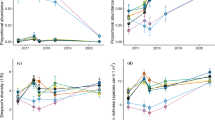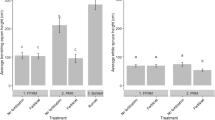Abstract
This study was implemented to determine the effects of one, two, or three months of establishment irrigation, after spring or summer seeding on the long-term composition of mined land plant associations. While the treatment plots were seeded with the same diverse mixture of native species, floristic differences among treatment combinations were apparent after five growing seasons. Summer seeding enhanced the development of seeded warm-season grasses by retarding the initial development of seeded cool-season grasses and by limiting competitive effects of nonseeded species through seedbed tillage. Supplemental irrigation was substantially more important to the development of warm- than cool-season grasses. Seeded perennial forbs performed poorly on all treatments, presumably due to low seed viability, low germination, and/or competition from more water-responsive species. Despite drought conditions during plant establishment, supplemental irrigation was not critical to the ultimate development of nonseeded plant species when seedbed tillage occurred shortly after topsoil was applied. However, irrigation became more important to the long-term development of these species when tillage was delayed. Most forbs encountered were perennial natives that had volunteered from the direct-haul topsoil.Atriplex canescens was the only successful seeded shrub and performed particularly well on the summer seeded plot that received one month of initial irrigation.
Similar content being viewed by others
References
Daubenmire, R.A. 1970. Steppe Vegetation of Washington. Washington Agr. Exp. Sta. Tech. Bull. 62.
DePuit, E.J. 1982. Cool-season grasses, successes and limitations.In: Surface Coal Mining and Reclamation in the Northern Great Plains. Symposium. Billings, Mont.
DePuit, E.J. and J.G. Coenenberg. 1979. Methods for establishment of native plant communities on topsoiled coal stripmine spoils in the Northern Great Plains. Reclamation Review,2:75–83.
DePuit, E.J., C.L. Skilbred, and J.G. Coenenberg. 1982. Effects of two years of irrigation on revegetation of coal surface-mined land in southeastern Montana. J. Range Manage,35:67–74.
Dollhopf, D.J., J.D. Goering, S.A. Young and R.B. Rennick. 1984. Response of seeded species to temporary irrigation on sodic minesoils at Decker, Montana. Montana Agr. Exp. Sta. Spe. Rep. (in progress).
Eddleman, L. 1982. Shrub establishment in reclamation of surface mined lands.In: Surface Coal Mining and Reclamation in the Northern Great Plains. Symposium. Billings, Mont.
McHenry, J.R. 1963. Theory and application of neutron scattering in measurement of soil moisture. Soil Sci.,95:294–307.
Meyn, R.L., E.S. Sundberg, and R.P. Young. 1976. Research on reclamation of surface mined lands at Colstrip, Montana: Progress report, 1975. Montana Agr. Exp. Sta. Res. Rep. 101.
National Oceanic and Atmospheric Administration. 1981. Climatological data: annual survey. U.S. Dept. of commerce, Environmental data and information service. V. 84 (13).
Plantenberg, P.L. 1983. The relative importance of factors affecting vegetation development on minesoils at Colstrip, Montana. M. Sc. Thesis, Montana State Univ., Bozeman.
Rennick, R.B., P.J. Hertzog, and F.F. Munshower. 1984. Native species response to fertilizers on surface mined land. Montana Agr. Exp. Sta. Spe. Rep. 11.
Richards, L. A. (editor) 1969. Diagnosis and Improvement of Saline and Alkali Soils. Agricultural Handbook 60, USDA.
Ries, R.E. and A.D. Day. 1978. Use of irrigation in reclamation in dry regions, pp. 505–520.In: Reclamation of Drastically Disturbed Lands. F.W. Schaller and P. Sutton (ed). American Society of Agronomy, Madison, WI.
Ries, R.E., R.F. Follet, F.M. Sandoval, and J.F. Power. 1978. Planting date and water affect initial establishment of perennial vegetative communities, pp. 899–905.In: Ecology and Coal Resource Development. M.K. Wali (ed). Pergamon Press, New York.
Schafer, W.M. 1983. Irrigation water quality in Montana. Mont-Guide, Montana Coop. Ext. Serv. Montana State Univ., Bozeman.
Sindelar, B.W. and P.L. Plantenberg. 1978. Establishment, succession, and stability of vegetation on surface mined lands in eastern Montana. Progress report, 1978, to U.S. Dept. of Energy. Montana Agr. Exp. Sta.
United States Department of Agriculture — Soil Conservation Service. 1982. National List of Scientific Plant Names. SCS-TP-159.
Wasser, C.H. 1982. Ecology and culture of selected species useful in revegetating disturbed lands in the West. U.S. Dept. Int. Fish and Wildlife Service. FWS-OBS-82-56.
Young, S.A. and R.B. Rennick. 1982. Establishment of Seeded species on coal surface minesoils following temporary irrigation. Montana Agr. Exp. Sta. Res. Rep. 200.
Author information
Authors and Affiliations
Additional information
Authors are research plant ccologist and director of research. This contribution submitted as Montana Agricultural Experiment Station Journal Series No. J-1560. This study was funded entirely by the Western Energy Company, Butte, Montana. The authors express their appreciation to Bill Schwarzkoph and Joe Cocnenberg of Western Energy Company, and former Reclamation Research Unit members Ed DePuit, Chet Skilbred, and Steve Young for their participation in the early stages of this study.
Rights and permissions
About this article
Cite this article
Rennick, R.B., Munshower, F.F. Effects of initial irrigation, seeding date and directlyhauled topsoil on mined land community composition. Environ Geochem Health 7, 110–115 (1985). https://doi.org/10.1007/BF01783557
Received:
Accepted:
Issue Date:
DOI: https://doi.org/10.1007/BF01783557




